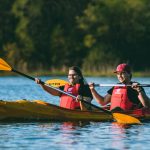Wondering what to wear kayaking? This beginner’s guide covers clothing, footwear & gear for every season. Stay safe, dry & comfortable.


Table of Contents
Introduction
Kayaking offers a unique way to experience the outdoors—whether it’s paddling across a quiet lake, navigating coastal waters, or floating down a gentle river. But many beginners overlook one key factor that determines how enjoyable (and safe) the trip will be: what you wear.
The right clothing can protect you from the sun, wind, and water while ensuring freedom of movement. More importantly, dressing properly can be the difference between a comfortable adventure and a dangerous situation if you capsize in cold water.
In this guide, we’ll break down exactly what to wear kayaking in different conditions, from warm summer days to cold winter paddles. You’ll also learn which fabrics to avoid, what footwear works best, and how to dress kids for kayaking.
Why Clothing Matters in Kayaking
Unlike other outdoor sports, kayaking has one non-negotiable: you will get wet—either from splashes, rain, or possibly capsizing. Your clothing needs to handle that reality.
- Comfort: Restrictive or heavy clothing makes paddling difficult.
- Safety: Cold water shock and hypothermia are real risks; dressing right reduces them.
- Performance: Lightweight, flexible materials allow smoother paddling.
- Protection: Clothing shields against sunburn, wind, and scrapes when getting in and out of the kayak.
👉 For a deeper breakdown of staying safe on the water, check our guide: Kayaking Safety Tips: 15 Rules Every Beginner Should Know.

Golden Rules for Kayaking Clothing
Before choosing specific items, keep these principles in mind:
- Dress for the water temperature, not the air. Even on warm days, cold water can sap body heat quickly.
- Avoid cotton. Cotton traps moisture, stays wet, and increases risk of hypothermia.
- Choose quick-drying synthetic or wool fabrics. Polyester, nylon, and merino wool are best.
- Layer smartly. Base layer, insulating layer, and outer waterproof layer are the key system.
- Prioritize safety over style. Bright colors improve visibility for other boaters.
Base Layers: The Foundation of Comfort
Your base layer is the clothing that sits directly against your skin. Its main job is moisture management.
- Best fabrics: Polyester, nylon, or merino wool.
- Avoid: Cotton t-shirts or sweatshirts.
- Fit: Should be snug but not restrictive to avoid chafing when paddling.
Example: A long-sleeve polyester shirt paired with lightweight athletic leggings makes a solid base.
Mid Layers: Insulation for Changing Conditions
The mid layer provides warmth if the temperature drops. Depending on the season, this could mean:
- Fleece pullovers for cool spring mornings.
- Synthetic insulated jackets that stay warm even if damp.
- Wool sweaters (fine in cold but dry conditions).
Think of the mid layer as optional—it’s more about adjusting to conditions rather than a must-wear for all trips.
Outer Layers: The Barrier Against Water
This layer protects against splashes, wind, and rain. Kayak-specific outerwear is best:
- Paddling jackets: Lightweight, waterproof, and designed for movement.
- Rain jackets: Work in a pinch but may restrict range of motion.
- Drysuits: Fully waterproof suits with tight seals at wrists, ankles, and neck. Best for cold-weather kayaking.
What to Wear Kayaking in Warm Weather
Summer paddling is often the easiest to dress for, but mistakes still happen. Many beginners overdress or underestimate sun exposure.
- Quick-dry shorts or leggings: Keep you cool and comfortable.
- Moisture-wicking shirt: Long sleeves with UPF rating are better than tank tops for sun protection.
- Hat: Wide-brim or cap to protect your face.
- Sunglasses with retainer strap: Polarized to reduce glare on the water.
- Water shoes or sandals with straps: Protect feet and provide grip.
What to Wear Kayaking in Cold Weather
Cold water kayaking demands a more technical approach.
- Wetsuit: Made from neoprene, it traps a thin layer of water against your body that warms up from body heat. Great for water temperatures between 50–70°F (10–21°C).
- Drysuit: Fully waterproof with seals at openings. Best for water under 50°F (10°C). Requires insulating base and mid layers underneath.
- Neoprene gloves: Keep hands warm while gripping the paddle.
- Booties: Insulated and snug-fitting to keep feet from freezing.
- Balaclava or neoprene hood: Reduces heat loss from the head.
According to the U.S. Coast Guard, cold water immersion is one of the top risks for paddlers. Proper clothing significantly reduces that danger.
Kayak Footwear Options
Choosing the right footwear matters more than most beginners realize. Your feet will get wet, so plan accordingly:
- Water shoes: Affordable, flexible, and good grip.
- Neoprene booties: Perfect for colder water.
- Sport sandals: Work in warm conditions, but open-toe designs risk cuts.
⚠️ Avoid: Flip-flops or bare feet. Both are unsafe and offer no protection against sharp rocks or slippery surfaces.
Accessories That Make a Difference
Sometimes it’s the small items that improve comfort the most:
- Paddling gloves: Reduce blisters and keep hands warm.
- Dry bags: Protect essentials like keys, snacks, and phones.
- Sun protection gear: Sunscreen, lip balm with SPF, and rash guards.
- Watch or waterproof GPS: Helpful for timing and navigation.
Seasonal Kayaking Clothing Guide
Different seasons demand different clothing approaches.
- Spring: Water is often colder than the air. A wetsuit plus a paddling jacket is ideal.
- Summer: Focus on sun protection. Lightweight, UPF-rated shirts are better than sleeveless tops.
- Fall: Unpredictable weather—bring layers. A fleece under a waterproof shell works well.
- Winter: Drysuit with insulating base layers. Add gloves, booties, and head protection.
👉 If you’re planning a family trip in any season, check our guide on Kayaking with Kids: Safety Tips and Best Family Kayaks.
Mistakes Beginners Make
- Wearing cotton, which stays wet and cold.
- Choosing heavy clothing like jeans.
- Forgetting sun protection.
- Overdressing in summer (leading to overheating).
- Underdressing in cold water (risking hypothermia).
What Kids Should Wear Kayaking
Dressing children for kayaking requires extra attention:
- Properly fitted PFD—never buy “to grow into.”
- Quick-dry shirts and shorts.
- Secure footwear (no flip-flops).
- Sun protection—UPF shirts, hats, and sunglasses.
Comfort keeps kids happy, and happy kids mean longer trips for the whole family.
Packing Checklist
Before heading out, run through this quick checklist:
- Moisture-wicking base layer
- Optional mid layer for warmth
- Waterproof outer shell
- PFD
- Hat, sunglasses, sunscreen
- Water shoes or booties
- Gloves (optional)
- Dry bag with essentials
FAQs
Can you wear jeans kayaking?
No. Jeans absorb water, become heavy, and restrict movement.
Do you need shoes while kayaking?
Yes. Shoes protect feet from rocks, sharp shells, and slipping.
What do you wear under a wetsuit or drysuit?
A thin synthetic or merino wool base layer works best.
Is it safe to kayak barefoot?
No. Bare feet are prone to cuts and slips.
Can you kayak in regular workout clothes?
Yes, if they’re synthetic (polyester/nylon). Avoid cotton.
Should you wear a life jacket over your clothes?
Always. A properly fitted PFD is essential, no matter how calm the water seems.
Conclusion
What you wear kayaking directly affects your safety, comfort, and enjoyment on the water. From lightweight UPF clothing in summer to insulating drysuits in winter, smart clothing choices make paddling a reliable and fun activity all year long.
For beginners, start simple: moisture-wicking layers, secure footwear, sun protection, and always a PFD. Once you build experience, you can upgrade to specialized wetsuits or drysuits for more challenging conditions.







